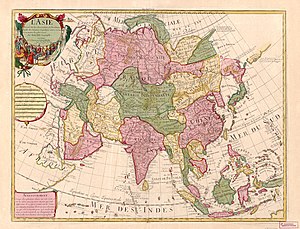Unsolved:Tartarian Empire (conspiracy theory)
Tartary or Tartaria is a historical name for Central Asia and Siberia. Ignorance surrounding Tartary's use as a place name has spawned conspiracy theories including ideas of a "hidden past" and "mud floods". Such theories assert that Tartary (or the "Tartarian Empire") was a lost civilization with advanced technology and culture. This ignores the well-documented history of Asia, which Tartary refers to.[1] In the present day, the Tartary region covers a region spanning from central Afghanistan to northern Kazakhstan, as well as areas in present Mongolia, China and the Russian Far East in "Chinese Tartary".
Background
The theory of Great Tartaria as a suppressed lost land or civilization originated in Russia , with aspects first appearing in Anatoly Fomenko’s New chronology, and then popularized by the racial occult history of Nikolai Levashov. In Russian pseudoscience, known for its nationalism, Tartaria is presented as the "real" name for Russia, which was maliciously "ignored" in the West.[2][3] The Russian Geographical Society has debunked the conspiracy theory as an extremist fantasy, and far from denying the existence of the term, has used the opportunity to share numerous maps of "Tartary" in its collection.[4] Since about 2016, conspiracy theories about the supposed lost empire of "Tartaria" have gained popularity on the Internet, divorced from its original Russian nationalist frame.[5]
Conspiracy theory
The globalized version of the conspiracy theory is based on an alternative view of architectural history. Adherents propose that demolished buildings such as the Singer Building, the original New York Penn Station, or the temporary grounds of the 1915's World's Fair were actually the buildings of a vast empire based in Tartary that has been suppressed from history. Sumptuously styled Gilded Age buildings are often held out as really having been built by the supposed Tartaria. Other buildings, such as the Great Pyramids and the White House, are further held out as Tartarian buildings. The conspiracy theory only vaguely describes how such a supposedly advanced civilization which had reputedly achieved world peace could have fallen and been hidden.[5][6]
In the conspiracy theory, the idea that a "mud flood" wiped out much of the world via depopulation and thus old buildings is common, supported by the fact that many buildings across the world have architectural elements like doors, windows and archways submerged many feet below "ground level". Both World War I and II are cited as a way in which Tartaria was destroyed and hidden, reflecting the reality that the extensive bombing campaigns of World War II did destroy many historic buildings. The general evidence for the theory is that there are similar styles of building around the world, such as capitol buildings with domes, or star forts. Also many photographs from the turn of the 20th century appear to show deserted city streets in many capital cities across the world. When people do start to appear in the photographs there is a striking contrast between the horse and cart dwellers in the muddy streets and the elaborate, highly ornate stone mega-structures which tower above the inhabitants of the cities, which is seen even in modern cities where extreme poverty is contrasted with skyscrapers.[5][6]
Zach Mortice writing for Bloomberg believes that the theory reflects a cultural discontent with modernism, and a supposition that traditional styles are inherently good and modern styles are bad. He describes the theory as "the QAnon of architecture".[6]
See also
References
- ↑ Dunning, Brian (February 2021). "Skeptoid #765: Tartaria and the Mud Flood". https://skeptoid.com/episodes/4765.
- ↑ Gorshenina 2014, pp. 462—463.
- ↑ Gorshenina 2019, p. 94.
- ↑ "Vsya pravda o Tartarii" (in ru). 2020-10-05. https://www.rgo.ru/ru/article/vsya-pravda-o-tartarii.
- ↑ 5.0 5.1 5.2 Adams, Josie (2022-01-14). "Inside the wild architecture conspiracy theory gaining traction online". https://thespinoff.co.nz/irl/14-01-2022/inside-the-wild-architecture-conspiracy-theory-gaining-traction-online.
- ↑ 6.0 6.1 6.2 Mortice, Zach (April 2021). "Inside the 'Tartarian Empire,' the QAnon of Architecture" (in en). Bloomberg News. https://www.bloomberg.com/news/features/2021-04-27/inside-architecture-s-wildest-conspiracy-theory.




